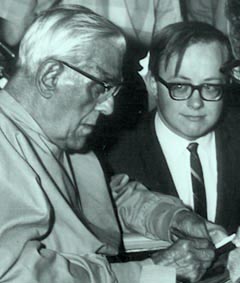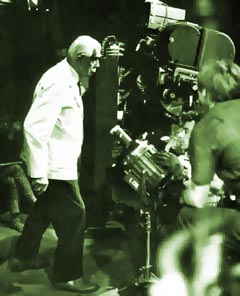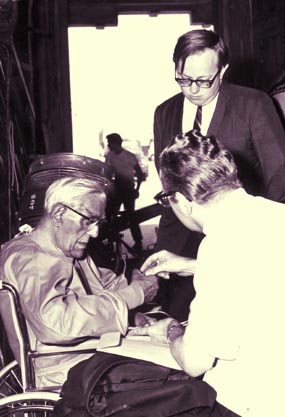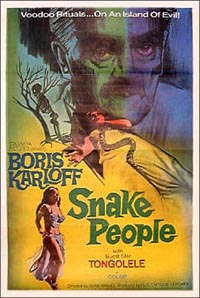|
The old man swayed back and forth on the bench before the wooden pipe organ, his arthritis-crippled fingers playing over
the silent keys. Behind and above him, with a hiss of gas, flames suddenly erupted. Dirt fell loosely from the ceiling, the
nearby slowly-turning water wheel caught fire and improbably halted. With thudding finality, a beam fell.
"Cut!" the director called. "Hurry up, you guys, right away." Even before he spoke, the special effects
crew dashed up to the raised area of the dungeon set with fire extinguishers and quenched the flames on the floor. Those
on the walls were turned off backstage
The old man, almost unnoticed in the busy hustle, made his way off the platform to the ever-present wheelchair. "Thanks,
Boris," the director said. Boris Karloff had finished the final scene of House of Evil, one of the last two movies
he would ever make. And still dizzy over being there, I stood in the background and watched.
I had first encountered Karloff in person about a year before he made those last four films, when I was invited to Milt
Larsen's wonderful Magic Castle to attend a press reception for the actor, publicizing his record album, An Evening with
Boris Karloff and His Friends. I was not introduced to him at that time but was one of several more-or-less anonymous
faces firing questions at him in one of the little magicians' showrooms at the Castle. Many of the questions were familiar,
and so were some of the answers. He seemed then to be a kind, thoughtful man, but also seemed to be very, very tired.
Then, in 1968, Boris Karloff returned to Los Angeles to make four films in five weeks in a co-production deal between Azteca
Films of Mexico and Hollywood's Columbia Pictures. Fortunately, in a sense, I was out of a job, so when Forry Ackerman invited
me to go to the sets with him, I had the time to do it. The first day, I met Luis Enrique Vergara, the Mexican producer
of all four films; we hit it off very well, and he invited me to come back as often as I liked. I took him up on the offer,
inviting fellow fan Jim Shapiro along one time, Jon Berg another. I didn't want to become a pest, so I actually stayed away
on several days I could have gone.

A Monster Kid's dream come true. Bill Warren (before he discovered Hawaiian shirts) with the Uncanny Karloff on the set of
The Fear Chamber.
That first day, I looked around the cramped soundstage, trying to find Karloff. As unlikely as it seems, he was hard to
spot initially, as he was seated in his wheelchair, obscured by set workers standing around him. No one was speaking to him,
and he appeared to be quietly drowsing. He was costumed for the part of the scientist of The Fear Chamber.
When I finally worked up the courage to speak to him (after being introduced by Forry), Karloff was quite friendly, but seemed
to have some trouble speaking. The weather was stifling hot and as he had only one half of one lung to breathe with, speech
was not easy for him. He answered my few questions, some of which I am sure he had been asked many times before but he responded
to all, graciously and honestly. He autographed some stills for me as well, but since I could see that even this minor exertion
was an effort, and since I was intensely nervous and almost terminally shy, I took my leave.
I was on the set of Isle of the Snake People only briefly, though in a sense I am in the movie: I was creeping around
the set behind the flats when the director called action. If the wall could be erased, you could see me, standing six feet
from Karloff. (Robert Bloch later told me the same thing happened with him on the set of Psycho: if you could see
through the fake walls of one of the sets, there you'd find Bob Bloch.)

Arthritis and emphysema can't stop trooper Karloff from valiantly performing without the aid of a wheelchair when the cameras
roll for House of Evil.
|
 |
|
|
|
|
|
 |
|
|
 |
|

Karloff signs copies of Famous Monsters of Filmland for editor Forrest J. Ackerman as Bill looks on.
I was on the sets for several days each for the third, House of Evil, and for the fourth, The Incredible Invasion.
He may have recognized one of the electrical gadgets on the set; it was one of Kenneth Strickfaden's devices, and had been
used in Frankenstein and Bride of Frankenstein, among many others.
Again, when I arrived, Karloff was seated to one side, out of the way, holding an oxygen mask to his face and studying his
lines. (All his career long, he prided himself on being a quick study.) Jon Berg today a special effects expert and I
hovered around him, not talking but merely pleased to be in his presence. We also half-heartedly tried to keep visitors to
the set from bothering him.
For example, a mother who was on the set dragged her son up to the tired old actor and said, as if Karloff weren't there,
"See? He played Frankenstein." The unimpressed boy said, "You mean Herman Munster?" As if he hadn't
heard them, Karloff at first didn't glance up. But when the woman spoke directly to him, he raised his head and smiled.
He spoke, as before, kindly and sincerely.

My respect for him as a craftsman and a hard worker went up when he was called to the set for his scenes. He arose from
his wheelchair, shedding twenty years in the process; despite the leg braces he wore, he walked to the set unassisted and
took his place. The chance to work, even under these circumstances, washed the years away. In the scene, Karloff was required
to bolt a door and suddenly pain distorted his face and he leaned heavily against the wall. There were audible gasps all
around the stage; Jon Berg stepped forward, hoping to help. I found that I had done the same. Then we all realized that
he was simply acting. Our concern for him, our apprehension over his courage, our awareness of his weakened physical condition,
and a lifetime of loving the man on screen had made us all want to help.
By this time, I'd seen him shoot many scenes with multiple takes of each, and I'd noticed something curious. I always assumed
that actors would repeat a performance exactly, in each take (and most do that), but Karloff varied each take slightly. He'd
move his head differently, change his gestures, alter the inflections of the lines.
I talked with him about this later on. He said that he had studied the script carefully, as always, so he'd know about his
character not only from his own lines and actions, but from what the other characters said and felt about his character. He
wanted to bring his part fully to life, knowing that in a fantastic movie, believability is of major importance. To produce
believability for the audience, he had to achieve it for himself. That was one reason he varied his performance from take
to take, while remaining within the boundaries of the character as he had interpreted them. "I've done it all my film
career," he told me. "I've discovered that it keeps one from becoming too stale. This is a very great danger in
working in films." His variations were always in character, and never would present any problems to the editor in fact,
they provided more choices.
Click below to continue
Karloff Page 2
|
 |
|
|
 |
|